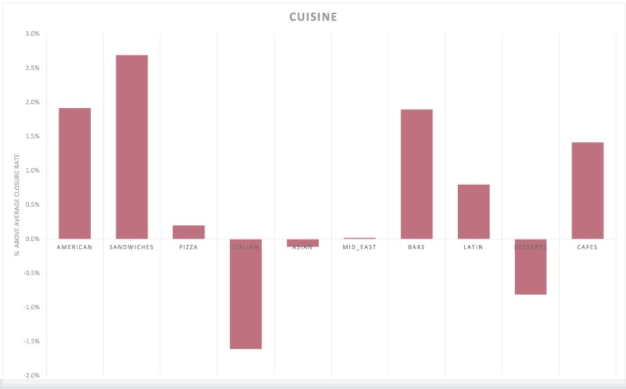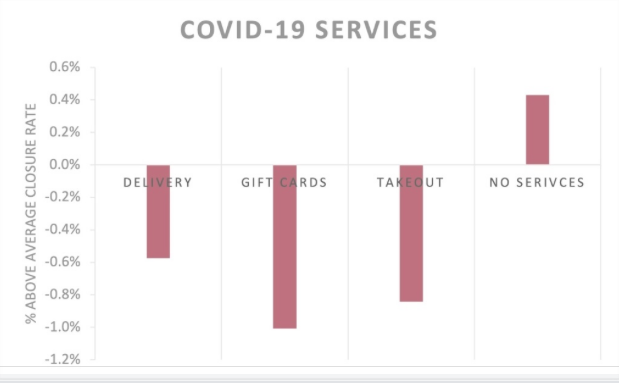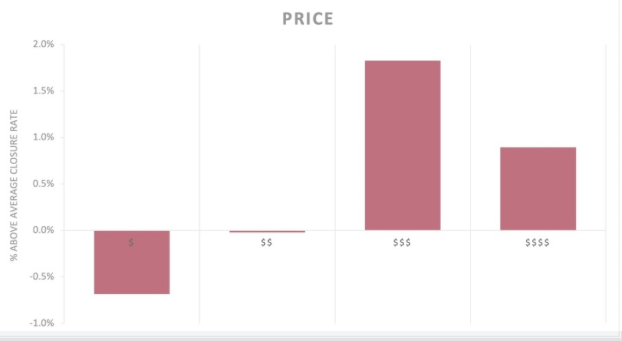Restaurant Survival in a Pandemic
Article by Julia Garbee and Angelina Astillero
The COVID-19 pandemic has had harrowing effects on restaurants across the country. Over 110,000 restaurants closed in the United States in 2020, eradicating nearly 2.5 million jobs. Indoor dining restrictions haven’t impacted all restaurants equally, though. Cuisine, hours, reputation, and services influence a restaurant’s likelihood of surviving the COVID-19 pandemic, according to our statistical analysis of Yelp data.1
Ellen Yin, founder and co-owner of High Street Hospitality Group, experienced first-hand the disproportionate pressure that the pandemic has had on her five Philadelphia restaurants, bars, and cafes. Yin’s insights suffuse the following sections of effects we discovered from our statistical analysis.
Lunch Effect
Remote work has eliminated the need to eat out during lunch breaks. Restaurants only serving lunch are suffering the most from COVID-19, according to our analysis. Lunch crowds have temporarily vanished from grab-and-go spots located in and around office buildings. The fast-casual restaurants designed for hungry office workers are now facing major setbacks, for some, even closure.
Hospitals were of the few industries that continued in-person work, making Yin’s decision to relocate High Street on Market’s property next to the highly trafficked Thomas Jefferson University Hospital easy. Her customer base shifted to doctors, nurses, and patients.
Breakfast out has always been a luxury. COVID-19 has heightened that. “We were known for our breakfast sandwiches,” says Yin. Fewer people wanting to splurge on breakfast during the pandemic meant that High Street removed their beloved breakfast sandwiches from the menu.
Restaurants serving exclusively dinner or serving dinner and breakfast were the least likely to close. Relative to dinner only restaurants, the odds of closure for breakfast only restaurants increase by 162.52% and the odds for closure for lunch only restaurants increase by 123.7%, according to our regression analysis. Eating dinner out, even if only occasionally, is a habit that few have abandoned during the pandemic. Those who frequently ordered takeout for dinner pre-pandemic continued to do so during the pandemic.
Cafe Effect
Cafés have faced serious closure during COVID-19. For restaurants labeled as ‘cafes’ on yelp, the odds of closure increase by 69.8% relative to restaurants labeled as ‘pizza’.
The usual cluster of people that work, read, or congregate at coffee shops has been decimated by indoor dining restrictions. And people that used to commute to an office everyday no longer need to stop and grab a quick coffee. Without indoor-diners and commuters, cafes face the tough decision of shutting down or offering to-go options. Chains, like Starbucks, that already had mobile ordering systems in place have a massive leg up on independent cafes.
Bar Effect
With many indoor seating restrictions and city-wide curfews, bars have had an especially difficult time staying open during the pandemic. For restaurants characterized as ‘bars’ on yelp, the odds of closure rise by 69.7% relative to restaurants labeled as ‘pizza’. As opposed to other types of restaurants, bars tend to have less table seating making social distancing unmanageable.
In addition to capacity limits, some states have imposed guidelines that prohibit serving alcoholic beverages unless accompanied by the purchase of food. The purpose of this requirement is to discourage any congregating and mingling that may arise in only drinking environments.
To combat the devastating effects of Covid-19 restrictions on bars, restaurant owners like Yin have opted to convert their bar spaces into to-go bottle shops selling wine, charcuteries, and a small selection of dinner and other meals.

COVID-19 Services
Restaurants and bars that have stayed afloat during the pandemic have relied on takeout, delivery, gift-cards, and outdoor dining structures. Restaurants the offered delivery during COVID-19 reduced their odds of closure by 59.7% relative to restaurants that don’t offer any services. Restaurants the offered takeout during COVID-19 reduced their odds of closure by 62% relative to restaurants that don’t offer any services. Restaurants the offered gift cards during COVID-19 reduced their odds of closure by 64.6% relative to restaurants that don’t offer any services. Restaurants offering delivery, takeout, and gift-cards may have reduced their likelihood of closure though the effects are more modest.

Reputation Effect
In the digital age, reputation is increasingly crucial to the success of a restaurant. Online review sites such as Yelp help people decide where to eat based off of the reviews and experiences of others. The brand image of a restaurant is built on both customer ratings and number of reviews. For every tenfold increase in the number of Yelp reviews a restaurant had, the odds of closure reduced by 49%, according to our regression analysis.
Yin acknowledges the difficulties in maintaining a restaurant’s reputation, saying that she wants people to think of her restaurant when things eventually reopen. Some restaurants willing to risk losing the momentum of their restaurant’s recognition have opted to temporarily close because operational costs have been higher than revenues. Some restaurant owners see this as the perfect time for remodeling, believing that while business is low, they can make improvements in time to reopen when things return to normal.
Location Effect
Stay at home orders have closed vacation destinations, college campuses, office buildings, and shopping centers. Restaurants that once thrived in these crowded, public spaces are experiencing a sharp decline in sales due to diminished foot traffic.
High Street Provisions, one of Yin’s restaurants, is centrally located on The University of Pennsylvania’s campus, typically serving the college students and administration. UPenn’s decision to shut down their campus caused an immediate decline in sales at High Street Provisions. On the other side of Philadelphia, High Street’s a.bar, visibility located in Rittenhouse Square, continued to attract throngs of people walking through Philadelphia’s busiest area.
Colder cities also faced outdoor dining challenges avoided by warmer cities. In Philadelphia, restaurants transformed sidewalks and parking lots into dining areas, complete with roofs and warming systems. These structures were a mere band-aid solution, though, as they required heating expenses, fewer customers, and in some cases, even a menu shift to heartier dishes.
Price Effect
With the increased use of take-out and delivery services, it is no surprise that lower-end restaurants are less likely to face closure than restaurants with a higher price range. The expected dine-in experience that typically accompanies dining at a high-end restaurant has been difficult to replicate outdoors and with indoor dining restrictions. Restaurants with price ratings of 3- or 4-dollar signs are 1-2 percentage points more likely to close than their cheaper counterparts.

Will restaurants return from hibernation in 2021? In Q4 of 2020, restaurants and food business owners opened 18,207 restaurants nationwide, down only 4% from Q4 of 2019. While mass vaccinations that make indoor dining safer may help revive the industry, many independent restauranters will face irreparable financial damage due to COVID-19.


